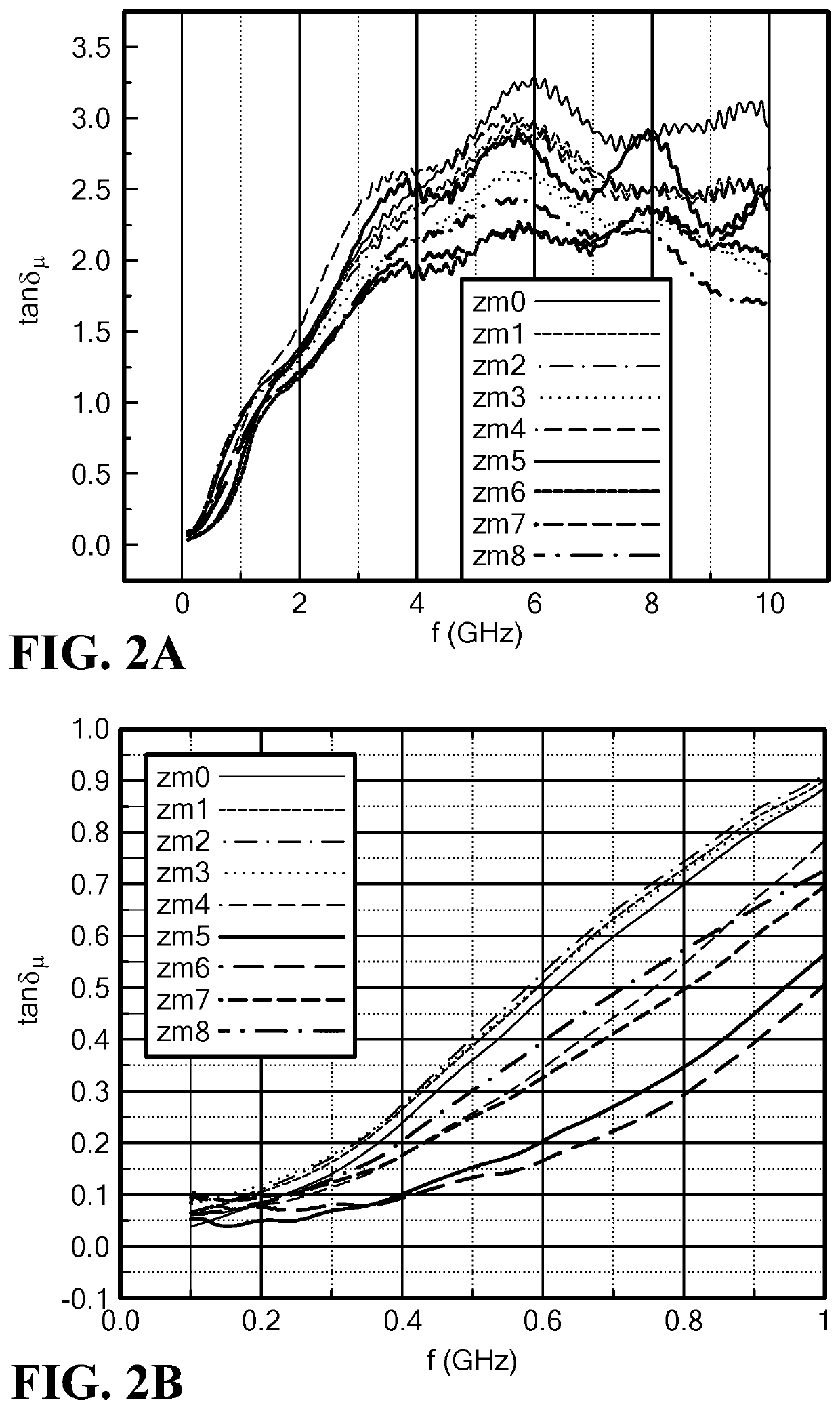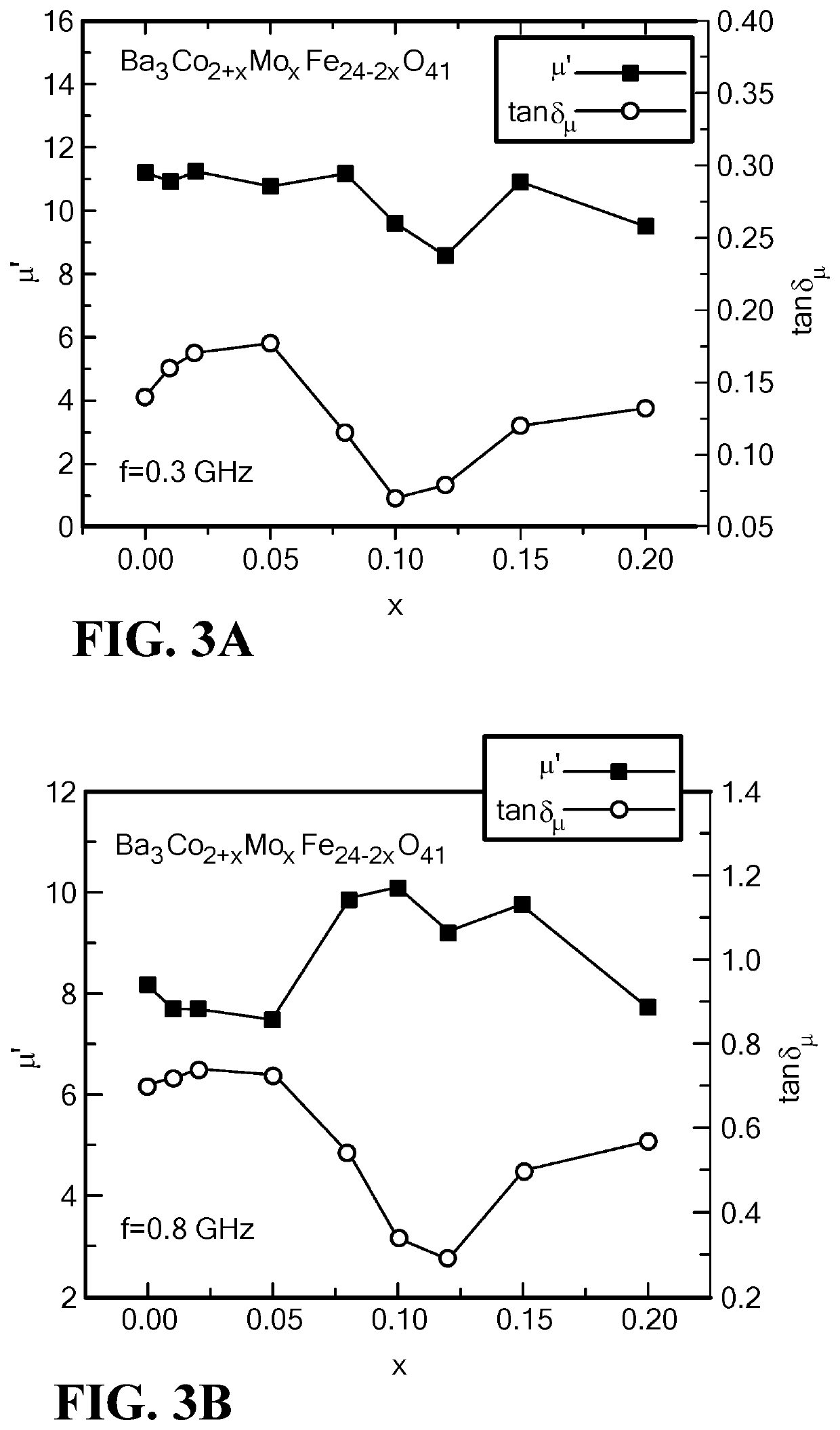Mo-doped Co2Z-type ferrite composite material for use ultra-high frequency antennas
a composite material and ultra-high frequency technology, applied in the direction of magnetism of inorganic materials, magnetic materials, magnetic bodies, etc., can solve the problems of not meeting the need for the design of a practical antenna, difficult to develop ferrite materials for such high frequency applications, and known ferrite materials exhibit relatively high magnetic losses at high frequencies. , to achieve the effect of low dielectric and magnetic losses, high frequency range, and permeability and permittivity
- Summary
- Abstract
- Description
- Claims
- Application Information
AI Technical Summary
Benefits of technology
Problems solved by technology
Method used
Image
Examples
example 1
[0150]Polycrystalline Co2Z hexaferrites, having the composition Ba3Co2+xMoxFe24-2xO41, where x=0, 0.01, 0.02, 0.05, 0.08, 0.10, 0.12, 0.15 and 0.20, were prepared by a two-step ceramic process. Starting materials of BaCO3, MoO2, Co3O4, and Fe2O3 were calcined in air for 6 hours at 1000° C., and then crushed and ball milled. The mixture, comprising 90 v % ferrite fine powders and 10 v % polyvinyl alcohol (PVA) binder, was pressed into a toroid with an outer diameter of 7 mm, inner diameter of 3 mm, and width of about 2 mm. This sample size is adequate for microwave measurements. Since oxygen atmosphere can help decrease the dielectric loss, the hexaferrite samples were sintered at 1200 to 1280° C. for 4 to 20 hours in oxygen as a final process step. (An annealing step, typically used to establish oxygen stoichiometry, was not used due to the long, 20-hour, heat treatment step.) Eight samples, listed with a corresponding identifying code ZM0 to ZM8, correspond to the inclusion of Mo i...
example 2
[0174]Polycrystalline hexaferrites having a non-stoichiometric composition with the formula (BazSr(3-z))Co(2+x)MoxFe(y-2x)O41 were produced. Table 5 lists the non-stoichiometric formulas for several samples that were prepared and tested.
[0175]
TABLE 5Formula design (non-stoichiometric formula)CodeFormulaMo content, xZSF1Ba3Co(2+x)Fe(21.6-2x)MoxO41x = 0.12ZSF2Ba3Co(2+x)Fe(22.4-2x)MoxO41x = 0.12ZSF3Ba1.5Sr1.5Co(2+x)Fe(21.6-2x)MoxO41x = 0.12ZSF4Ba1.5Sr1.5Co(2+x)Fe(22.4-2x)MoxO41x = 0.12
[0176]The fabrication process began with the following raw materials and their purities: BaCO3 (99.95%), SrCO3 (99.95%), Co3O4 (99.7%), MoO2 (99%), and Fe2O3 (99.95%). The ratio of each was selected to be consistent with the targeted nominal compositions. For example, the hexaferrite phase precursor compounds can comprise 0 to 0.96 wt. % MoO2, 22.10-22.18 wt. % BaCO3, 6.02-6.59 wt. % Co3O4, and 70.35-71.8 wt. % Fe2O3.
[0177]The materials were mixed with reagent alcohol as a solvent and ground in an agate j...
example 3
[0189]Polycrystalline Co2Z hexaferrites, having the composition Sr3Co2+xMoxFe24-2xO41, where x=0, 0.02, 0.05, 0.08, 0.10, 0.12, 0.15 and 0.20, were prepared by the two-step ceramic process described above in Example 1, using as starting materials SrCO3, MoO2, Co3O4, and Fe2O3.
[0190]Results
1. Magnetic Permeability Spectra and Magnetic Loss
[0191]The permeability spectra were measured over frequencies of 0.1 to 10.0 GHz. The permeability exhibits a decrease from 3.8 to 3.3 at low frequency (0.1 GHz) with Mo content, except for a Mo content of x=0.10, as seen in FIG. 16. The Mo content gives rise to a shift of the loss tangent peak to higher frequencies above 5.0 GHz, as seen in FIG. 17. The Mo content x=0.10 results in a minimum loss tangent at the frequency range from 0.4 to 1.5 GHz, also seen in FIG. 17. That is, the loss tangent for x=0.20 is ˜0.1 at 0.4 GHz and 0.4 at 1.5 GHz, which is the lowest loss among the Mo-doped SrCo2Z ferrites.
[0192]FIG. 18 illustrates the results of perme...
PUM
| Property | Measurement | Unit |
|---|---|---|
| frequency | aaaaa | aaaaa |
| frequency | aaaaa | aaaaa |
| frequency | aaaaa | aaaaa |
Abstract
Description
Claims
Application Information
 Login to View More
Login to View More - R&D
- Intellectual Property
- Life Sciences
- Materials
- Tech Scout
- Unparalleled Data Quality
- Higher Quality Content
- 60% Fewer Hallucinations
Browse by: Latest US Patents, China's latest patents, Technical Efficacy Thesaurus, Application Domain, Technology Topic, Popular Technical Reports.
© 2025 PatSnap. All rights reserved.Legal|Privacy policy|Modern Slavery Act Transparency Statement|Sitemap|About US| Contact US: help@patsnap.com



